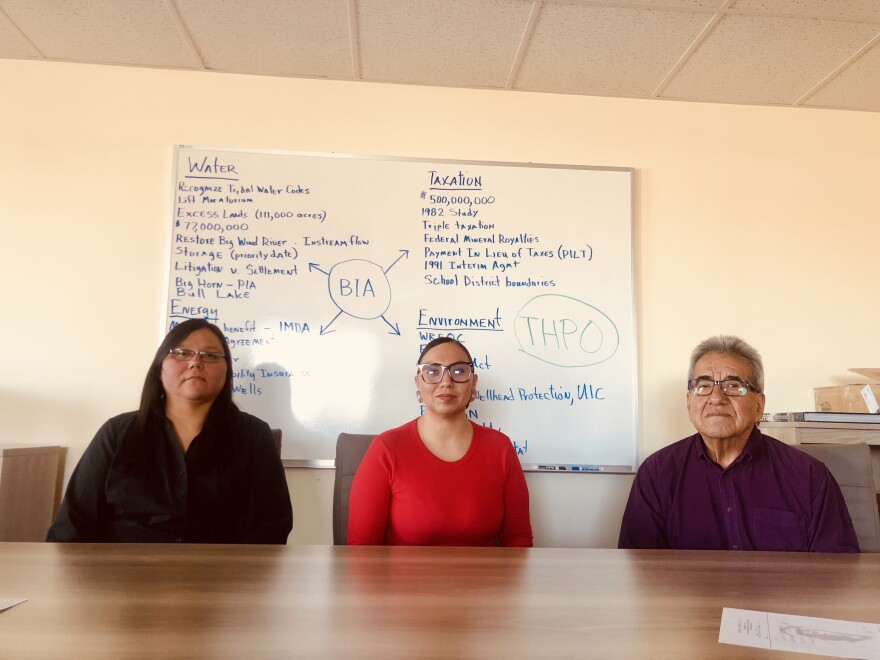The Greater Yellowstone Coalition, a conservation group that focuses on maintaining the Yellowstone Ecosystem, now has an office in Fort Washakie. Their goal is to strengthen the tribal influence on conservation efforts in the Yellowstone area. Wyoming Public Radio's Taylar Stagner spoke with the head of the Wind River Office Wes Martel about preserving treaty rights.
Taylar Stagner: Could you tell me a little bit about your history? You used to be on the Eastern Shoshone Business Council.
Wes Martel: I spent 20 years on the Eastern Shoshone Business Council. And when I first got on in 1979, the big issue that was firing up was the Big Horn adjudication. And just my first two weeks on the council, we started talking about - we had a whole bunch of attorneys and engineers and hydrologists and consultants and fed reps and all kinds of people - talking about this. It was pretty scary.
TS: Can you tell me a little bit about what the Bighorn adjudication is?
WM: The State of Wyoming took the tribes to court in 1977 to determine the amount of water that we're entitled to here at Wind River. And in that equation, they use the McCarran amendment which was adopted in Congress back in 1953, which allows federal Indian water rights cases to be taken into state courts. So, our Wind River Indian Restoration federal Indian treaty rights got taken into state courts.
And so that was the whole basis of the adjudication. And then they used our treaty against us and restricted us to one use, which was agriculture. So on an average year, there's 1.3 million acre-feet of water on the Wind River Reservation, and we got awarded 500,717 acre-feet of water. So, that's actually about 38 percent of the water. The state took about 62 percent of our surface water under that adjudication, basically about two-thirds of our water. And then to add insult to injury, they said we have no reserved right to groundwater.
And so that goes against every precedent of federal Indian law, and it goes against our treaties. So there's still a lot of work to do in Indian country and protecting water rights.
TS: Water is a big, contentious, contentious issue here in the West. And how does that tie in with the ecosystem here?
WM: Well, the mission of the Greater Yellowstone Coalition to protect the land waters and wildlife of the Greater Yellowstone Ecosystem, Wind River is part of that greater Yellowstone ecosystem, as a lot of other tribes. When we talk about water, that directly connects protecting land waters and wildlife, and directly connects to the economy and connects to our traditions. It connects politically.
There's a lot of connections that water has to the outside world. So our work on water is focusing on the health of our rivers, the health of our mountains, the health of our wildlife and big game and fisheries and birds. And so that's really a direct connection to the Greater Yellowstone Coalition work and the work that we need to do here on the rez.
The reservation is two and a half million acres; Yellowstone National Park is two and a half million acres. So we're the same size. I like to say we have everything that Yellowstone has except Old Faithful. We've got grizzlies, wolves, mountain lions and hot springs. We're only 42 miles from Yellowstone. We're trying to increase our buffalo herds. We're trying to protect our rivers. That all connects to conservation. And that conservation is a major natural law that Indigenous people followed. You take care of us, we take care of you.
TS: I'd like to talk a little bit about the history of the Shoshone in Yellowstone. Can you tell me a little bit about that?
WM: We're digging up old recordings and old interviews where the elders are telling their stories about the direct connection to Yellowstone where they used to go up and gather whole ceremonies to heal themselves in a hot water hunt. And so when you really look back at it, Yellowstone Park was like our grocery store, our restaurant, our pharmacy, our hospital, our church.
In 1870, prior to March 1 of 1872, when they were going to create Yellowstone as the first national park, the Calvary and the federal government moved in, and they killed a lot of Indian people and forcibly removed a lot of Indian people from Yellowstone in order to create the national park.
That's what we need to revive the fact that Yellowstone National Park still has a lot of special and spiritual significance to a lot of Indigenous people.
TS: What's it going to take to, I suppose, take better steps towards tribal inclusion with management of the park?
WM: We've really got to educate people about our treaties. And yeah, most Americans probably don't even know treaties exist. And even most of us as tribal members, we don't really understand our treaty. To a lot of people, a treaty is just a piece of paper. And our intent is to make sure that we work number one here at Wind River and our tribal councils to figure out how we breathe life into our treaties. How do we make sure that the way of life that our ancestors were trying to protect when they signed our treaties is actually protected? Right now it's not.








